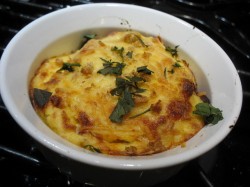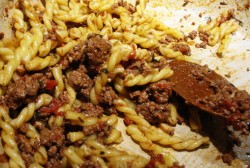Another Greek Casserole: Pastitsio
For those rare souls who do not love moussaka, (and this dislike usually comes about because of an aversion to eggplant–something which I cannot understand myself, but which does afflict a not insignificant number of people–like Zak) there is another Greek casserole, one that is luckily, even less trouble to make, and which tastes pretty darned good: pastitsio.
I am told that the name itself is a Greek version of the Italian term, “pasticcio” which I am told means, “hodgepodge.” “Hodgepodge,” of course, in English means “a collection of disparate things.”
Which doesn’t sound very enticing when it comes to food, does it?
Well, rest assured, that pastitsio is not just a bunch of stuff thrown together willy-nilly, nor is it a dumping ground for just whatever one has on hand, though, I must say that a cook could do worse than riff off this dish by adding a few seasonal vegetables such as zucchini or dare I say it–eggplant–to the mixture.
The basic idea behind pastitsio is that of a layered casserole that consists of a bottom layer of tubular pasta bound together with a cheese and egg mixture (ooh–starts off sounding like Greek macaroni and cheese–how can this be bad?) with the next layer being ground lamb or beef cooked with spices in a tomato sauce, with another layer of pasta and then a layer of egg custard topped with bechamel.
My way of making it comes from Sylvia, my mother’s friend Pete’s wife, who was sent by Pete’s mother from Greece to be his bride, sight unseen, back in the sixties. The two of them owned a diner, which my mother frequented every day when she worked as a computer programmer back before I was born, and while what they served to most customers was typical American lunch-counter fare–Sylvia also cooked up Greek specialities and served them to their Greek customers, to themselves and to folks like my Mom who had become family.
Sylvia simplified pastitsio incredibly, and I remember tasting it while sitting on her lap while she took a lunch break and talked to Mom who was taking a break from shopping with a small child in tow. Sylvia loved feeding me tidbits of whatever she was eating, and was always thrilled that I liked it and asked for more, my mouth opening like a little bird’s as she popped a fork containing one of her delicious mysteries into my mouth. Mom was always embarressed by my shamelessness in begging for another bite of free food, but Sylvia always laughed her off and said she was only sharing, and that my manners were in no way rough.
Sylvia was my kind of friend!
Anyway, back to her pastitsio–she mixed the meat sauce and macaroni (she always used elbow macaroni, because she already had it in the pantry to make American macaroni salad with it) and then topped it with the egg-enriched bechameil that went on top of moussaka, though it was firmer, so I suspect that in addition to adding more cheese to the dish, she added yet another egg yolk, which helps turn the bechamel into a puffy, light custard. She always finished the dish with a sprinkling of grated parmesan cheese, which gave it a brown crust that was delectable. Her final touch was a sprinkling of just-minced parsley, which gave a green fresh sparkle to the dish when it came steaming from the kitchen.
The whole thing was comfort on a plate, and I cannot really ever taste it without thinking of sitting comfortably on her lap, leaned against her chest, secure and warm in her embrace, and watching her eat dainty bites of fragrant pastitsio. I remember how when I would look up at her and pop open my mouth, she would take a tiny forkful, blow on it copiously to cool it, and then slip it between my lips. I can remember how the custardy bechanel would embrace the meat and macaroni mixture in a velvety-smooth cloak of richness, while the spices in the meat sauce would dance on my tongue. The cheesy crust was chewy and salty and the flecks of parsley were like a sweet chorus of birds on my palate, singing the entire dish to completion.
Here is my simplified version; if you want to make this for the freezer, make it as written all the way up to the step of actually baking it. Cover the casserole with tightly sealed foil, and freeze. To cook, take out, do not thaw and bake at 375 for probably 45-50 minutes, covered, though you should start checking on it after 20 minutes or so. After it is hot and bubbly, take the cover off and bake it for a further 10-20 minutes to brown the cheese on the top and get the bechamel to get all puffy and custard-like.
Pastitsio
Ingredients
1 pound tubular pasta cooked until al dente in salted water and drained
Meat sauce made from my recipe for moussaka with a generous pinch of nutmeg added with the other spices
1 cup parmesan cheese, or parmesan and gruyere mixed half and half, shredded
bechamel made from my recipe for moussaka, made with three cups of milk and a total of four egg yolks, with 1/4 cup shredded gruyere and two tablespoons fresh minced parsley added
minced fresh parsley and mint in whatever amount you would like as garnish
Method:
Preheat oven to 350 degrees F.
Mix together pasta and meat/tomato sauce, then spoon into a well-oiled (I use olive oil spray) 9X13 casserole dish.
Sprinkle with half the cheese.
Pour over 1/3 the bechamel, and gently stir into the pasta and sauce to mix the layers very lightly. You want the first layer of bechamel to penetrate the meat and pasta slightly, but you do not want it thoroughly mixed. Sprinkle with 1/2 the remaining shredded cheese, then top with the rest of the bechamel, and sprinkle with the last of the shredded cheese.
Put into oven and bake for about 40-45 minutes, though I suggest checking after twenty-five to make sure the cheese on top isn’t browning too rapidly. If it is, loosely cover it with a tent of foil and continue baking until the bechamel forms a puffy, brown-topped custard, and everything smells bubbly hot and delicious.
Serve with the parsley and mint sprinkled over the top. Needless to say, a big bowl of Greek Salad is not remiss with this comforting dish.
9 Comments
RSS feed for comments on this post.
Sorry, the comment form is closed at this time.
Powered by WordPress. Graphics by Zak Kramer.
Design update by Daniel Trout.
Entries and comments feeds.





Cool! It’s kind of like a well-insulated lasagne.
Comment by Hadar — September 4, 2006 #
It sounds fabulous. I have a friend who is Greek and her dad makes this every year for Christmas. Your version sounds very similar to his recipe. Eating Nick’s Pastitsio is a Christmas tradition I always look forward to.
Comment by kalyn — September 4, 2006 #
That is a good analogy, Hadar–it is a very similar idea, but easier to do.
Kalyn–pastitsio is definately something to look forward to!
Comment by Barbara — September 4, 2006 #
I love this stuff – though when my mom made it she called it “macaroni bake”!
Comment by Rosie — September 4, 2006 #
I use the word hodgepodge way too often, I will now always say, pasticcio.
The recipe sounds great too!
🙂
Comment by Rachael — September 4, 2006 #
Love your story. It brings back memories of being with my Greek family and my aunties cooking up all these wonderful Greek dishes.
Comment by Isis — September 5, 2006 #
If someone doesn’t like eggplant, another option is pumpkin moussaka. I usually make this with roast butternut squash in place of the eggplant, although roast pumpkin will also work (obviously), if you can find it.
Comment by Cris — September 5, 2006 #
Cris–pumpkin moussaka would never fly with Zak. He dislikes pumpkin and sqash worse than he dislikes eggplant. He will at least eat baba ganoush–but will not touch anything squashy.
Comment by Barbara — September 7, 2006 #
[…] frozen moussaka, pastitsio and lasagne this way and baked them both thawed and frozen and they all come out of the oven […]
Pingback by Tigers & Strawberries » Cooking Ahead: The Slacker Method — June 25, 2011 #